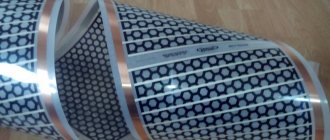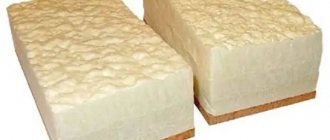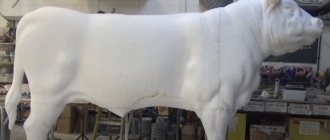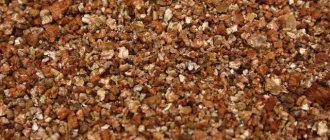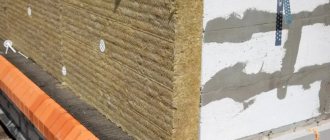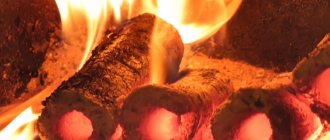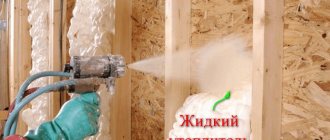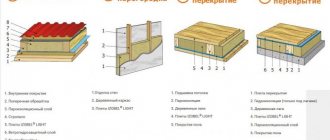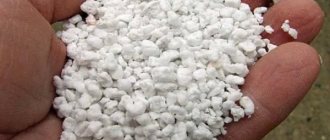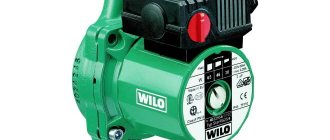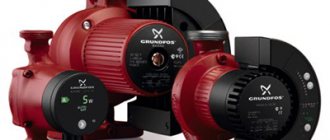One of my orders included insulation of a private façade. The client was faced with a dilemma regarding the choice between polystyrene foam and extruded polystyrene foam. I had to explain in detail how polystyrene foam differs from expanded polystyrene - in this case, the latter was chosen. In this review, I also decided to share with you what is the main difference between two similar materials on such grounds as production, characteristics, pros and cons, application, selection criteria.
Source stroyka-gid.ru
Polystyrene foam and polystyrene foam - features, production, characteristics
Polystyrene foam is a foamed polymer material. Expanded polystyrene, in turn, is a dense gas-filled structure, the basis of which is polystyrene. They differ primarily in production technology and, as a result, in slightly different properties and scope of application. In this case, various polymers and their combinations can be used as raw materials:
- Polyvinyl chloride.
- Polystyrene.
- Polyurethane.
- Phenol formaldehyde.
- Formaldehyde with urea.
For the production of polystyrene foam, a special gas blowing agent is used - pentane. In the classic case, the raw material is styrene, the mass fraction of which ultimately does not exceed 2%. The technological cycle consists of the following stages:
- Transformation of raw material granules into a foamy state under the influence of high-temperature steam.
- Transfer to drying unit.
- Foam curing.
- Repeated foaming (the number of procedures depends on the required density of the product).
- Cooling and monolith formation.
- Cutting into slabs.
Source stroy-podskazka.ru
The manufacturing process of expanded polystyrene begins in the same way as polystyrene foam; the difference is noticeable only at the foaming stage. Here special additives are added to the mass. Next, the melt is transferred to an extruder, where it is exposed to highly heated steam. After the substance has acquired a homogeneous structure, it is squeezed out under pressure into equipment for subsequent cooling and giving the required shape.
Due to slightly different manufacturing technologies, both materials also have different practical characteristics:
- Moisture saturation. Polystyrene foam absorbs water approximately 4 times more than polystyrene foam.
- Thermal conductivity. Expanded polystyrene is characterized by a lower thermal conductivity coefficient, making it the best insulation material.
- Strength and durability. Expanded polystyrene has the best performance.
- Compression resistance and density. In 1st place is polystyrene foam material.
Due to the fact that from a chemical point of view there is practically no difference between polystyrene foam and polystyrene foam, they both have similar operating temperature conditions - from -50 °C to +70 °C.
Source maximuscentr.com.ua
A mistake when insulating a house, which will later be very expensive
During the construction of three-row brick walls, in order to save money, they try to use the cheapest polystyrene foam as insulation, and this is fraught with consequences, since expanded polystyrene foam tends to collapse under the influence of humidity. And if you place it between two masonry walls, as usually happens in practice, then over time you can get empty walls, and the destroyed insulation will settle at the base of the walls.
And an even more destructive effect will be if such material is installed inside wooden walls. During the cold season, a dew point will appear in such walls and moisture will accumulate, which, at the first frost, will begin to destroy the wooden walls of your house. Read more about the occurrence of dew point in the article: “Dew point in construction. Dew point calculation »
insulation with expanded polystyrene between rough and facing masonry
If technical errors made when installing polystyrene foam boards on the facade of a building can still be eliminated by direct access to the problem area, then if this material is located inside the wall, then it will be impossible to eliminate the harmful consequences without significant costs and dismantling the walls.
dew point inside polystyrene foam, between walls
Expanded polystyrene is an effective and convenient material of its kind, but it must be used where it really brings benefits.
Advantages and disadvantages
Each type of materials under consideration has its own set of advantages and disadvantages:
- Styrofoam.
Positive properties:
- 98% consists of air pores.
- 3 times less thermal conductivity than dried wood.
- Minimum weight for easy transportation and installation.
- Low cost.
- Soundproofing qualities with a minimum layer.
- Moisture saturation by no more than 3%, as a result of which the thermal insulation abilities are completely preserved.
- Good workability – cutting, painting, plastering, finishing.
- Resistance to contact with building materials and substances.
- Sufficient environmental safety.
Negative features manifest themselves primarily in flammability, fragility and low adhesive properties. In addition, when exposed to damp for a long time, the structure is destroyed and the properties of the material are lost.
Source doorchange.ru
- Expanded polystyrene.
Unlike polystyrene foam, polystyrene foam is characterized by maximum strength and does not support combustion. In addition, it has the following set of advantages:
- The minimum thermal conductivity coefficient is 4-5 times less than that of wood.
- It practically does not absorb moisture and does not allow steam to pass through, making it suitable for use in damp rooms and outdoors.
- High bending and compressive strength.
- Long service life - from 50 years.
- Soundproofing properties.
The disadvantages of the material are manifested in high cost.
On a note! Expanded polystyrene material has proven itself as insulation resistant to external factors. It retains heat well in the room, does not dampen, has minimal shrinkage, and does not collapse under moderate loads and direct exposure to sunlight.
Bathroom floor insulation with polystyrene foam. Insulation of the bathroom
Many people have experienced a feeling of discomfort while in the bathroom. This is due to the fact that cool air enters from the sewer shaft and other cracks.
To avoid such unpleasant sensations, the bathroom must be insulated correctly, using only high-quality materials:
- The wall is cleaned and coated with a preparation that prevents the formation of fungus;
- Glue penofol or extruded foam to the wall;
- Moisture-resistant drywall is glued over the glued material;
- Ceramic tiles are laid on top of the drywall.
There is another way to insulate bathroom walls:
- In addition, it may be necessary to insulate the bathroom ceiling; the best option is to install a suspended plasterboard ceiling. The space between the ceiling and drywall is insulated with foam plastic.
Useful: A lighter option is decorative foam elements, such as wallpaper or foam tiles.
It is also important that the bathroom ventilation effectively removes the vapors generated in the house outside. In order to insulate the ventilation, you should prevent air from the street from entering the bathroom through it.
This is achieved by installing special grilles with a fan on the ventilation openings, which draws out vapors without allowing outside air into the room. In any case, the sewer shaft should be insulated, since it is a source of drafts that draw out heat and prevent the bathroom from warming up properly.
Application area
Due to its high density, durability and insulating ability, polystyrene foam is used mainly as a thermal insulation material, but polystyrene foam finds many more applications and is better suited for the following areas:
- Watercraft, boats, lifebuoys.
Video about what polystyrene foam is and how it is produced:
- Dielectric products.
- Furniture elements.
- Packaging containers.
- Blanks.
Polystyrene foam can also be used as insulation, provided there are no damaging loads, protection from rodents and fire.
1.5 Tendency to shrink
Shrinkage, like moisture absorption, is the main enemy of any insulation. When the material shrinks, cracks appear in the thermal insulation structure, which significantly reduce the overall insulation efficiency.
One of the main problems of polystyrene foam is its tendency to shrink when heated. Deformation manifests itself to a greater extent when the product is heated; therefore, it is better not to use polystyrene foam for thermal insulation of heated floor systems, and when insulating a facade with polystyrene foam, the insulation must be covered with white plaster, which protects from UV rays.
Things are much better with extruded polystyrene foam; the material practically does not shrink under any operating conditions.
Components of polystyrene foam beads
Criterias of choice
In order to decide which of the materials under consideration is best suited for specific conditions, it is necessary to take into account the following criteria:
- What types of work will be carried out with it.
- Characteristics of the material according to GOST and other standards.
- Resistance to destructive factors arising at the site of application.
- Features of products of specific brands.
Note! When choosing a thermal insulation material, it is necessary to take into account that the main difference between polystyrene and foam plastic is that the first is not afraid of moisture, fire, is more durable and accurate in size, and in most cases has a locking system at the edges that prevents the formation of cold bridges.
Video review on how to properly insulate with polystyrene foam and expanded polystyrene:
Penoizol - polystyrene foam based on urea-formaldehyde
In addition to polystyrene, other polymers are also used in the production of foam plastics. Material based on urea-formaldehyde has become widespread. It is more often called penoizol. The production of penoizol is quite complex, and in our country it was not widely used in construction until the 90s of the last century.
The process of making penoizol consists of creating foam and enveloping the cells with karmamide resin. The material hardens within 2-3 days and acquires excellent characteristics - the material is quite dense and has low thermal conductivity.
Penoizol is produced in the form of standard slabs, but is most often used in construction work in a liquid state - during the preparation process at the workplace. This has great advantages in terms of installation work:
- Filling the hardest-to-reach places with thermal insulation
- There is no need for preliminary calculations for the purchase of materials
- No additional fasteners
However, the use of penoizol during the construction process requires special equipment. It is clear that in this case, only specialized teams can carry out the insulation work.
Spraying penoizol requires special equipment
Colored polystyrene
The material may or may not be transparent. To make transparent sheets, fewer additives are mixed into polystyrene. The result is material that is labeled GPPS. It has its disadvantages, such as fragility and less ductility.
Transparent polystyrene, as its name suggests, is used for glazing interior spaces. This glazing is the safest; sheets of such polystyrene can also be corrugated or tinted; such materials are most often used to build partitions and shower stalls. White corrugated sheets are most often used when installing suspended ceilings. This polymer is also used to make anti-reflective protection, for example for paintings, while preserving the natural colors of the painting.
Transparent polystyrene granules are made in the form of a cylindrical shape. Processing is carried out by casting or extrusion process accompanied by high temperatures up to +230°C. Polystyrene serves as a raw material base in the production of various plastics. The low cost of polystyrene contributes to the development of production and a huge number of brands according to classifications are released.
Household items made of polystyrene literally filled our homes; fortunately, polystyrene does not harm human health at all. Children's toys, all kinds of packaging, toothbrushes, disposable tableware - a small part of surrounding us with polystyrene. Builders are more interested in foamed polystyrene; the characteristics of the material allow them to build insulating structures even in a humid climate.
Advantages of polystyrene:
- Easy processing;
- Easy transportation;
- Reasonable price of polystyrene;
- Waterproof;
- No smell;
- Polystyrene is an environmentally friendly product;
Polystyrene has disadvantages:
- fragile structure of the material;
- low thermal resistance;
- low resistance to shock loads.
Low cost contributes to the widespread use of polystyrene (PS). A large classification by brand allows you to select polystyrene for any needs in the national economy. Polystyrene with rigid and impact-resistant characteristics has become widely used.
Types of granules
Let's look at two main types: foam balls and crushed balls.
There are granules of ideal spherical shape. They are called foam balls. This is the most common type of granules. Their variety is “polytherm” - granules coated with a special adhesive composition. “Polytherm” is resistant to chemicals, durable, and does not shrink. Thanks to its use in building mixtures, the cost of construction is reduced. Also, “polytherm” (granules with a larger fraction - 3-7 mm) is used to create polystyrene concrete.
Manufacturers also sell the result of secondary processing of foam scraps. This is the so-called “crushed”. The shape of these granules is not ideal, the size is from 2 to 7 mm. And it costs less than standard foam balls. “Crushed” is used wherever it is possible to use polystyrene foam that is not ideally shaped:
- as part of any building mixtures,
- in the production of frameless furniture,
- for thermal insulation of pipes,
- as a shock-absorbing layer,
- to create a thermal insulation layer in walls and foundations,
- when installing flat roofs,
- for simulating snow at festive events, in theaters, on movie sets.
